Suppose you are provided with an actively dividing culture of E.coli bacteria to which radioactive thymine has been added. What would happen if a cell replicates once in the presence of this radioactive base?
A) Neither of the two daughter cells would be radioactive
B) One of the daughter cells, but not the other, would have radioactive DNA.
C) All four bases of the DNA would be radioactive.
D) DNA in both daughter cells would be radioactive.
Answer: D
In E.coli, there is a mutation in a gene called dnaB that alters the helicase that normally acts at the origin. Which of the following would you expect as a result of the this mutation?
A) No replication fork will be formed.
B) Additional proofreading will occur.
C) Réplication will occur via RNA polymerase alone.
D) Replication will require a DNA template from another source.
Answer: A
In E.coli, which enzyme catalyzes the elongation of a new DNA strand in the 5' --> 3' direction?
A) helicase
B) primase
C) DNA ligase
D) DNA polymerase III
Answer: D
Eukaryotic telomeres replicate differently than the rest of the chromosome. This is a consequence of which of the following?
A) DNA polymerase that cannot replicate the leading strand template to its 5' end
B) gaps left at the 5' end of the lagging strand
C) gaps left at the 3' end of the lagging strand because of the need for a primer
D) the evolution of telomerase enzyme
Answer: B
How does the enzyme telomerase meet the challenge of replicating the ends of linear chromosomes?
A) It adds numerous GC pairs, which resist hydrolysis and maintain chromosome integrity.
B) It adds a single 5' cap structure that resists degradation by nucleases.
C) It catalyzes the lengthening of telomeres, compensating for the shortening that could occur during replication without telomerase activity.
D) It causes specific double-strand DNA breaks that result in blunt ends on both stands.
Answer: C
Replication in prokaryotes differs from replication in eukaryotes for which of the following reasons?
A) The rate of elongation during DNA replication is slower in prokaryotes than in eukaryotes.
B) Prokaryotes produce Okazaki fragments during DNA replication, but eukaryotes do not.
C) Prokaryotic chromosomes have a single origin of replication, whereas eukaryotic chromosomes have many.
D) Prokaryotic chromosomes have histones, whereas eukaryotic chromosomes do not.
Answer: C
What is meant by the description "antiparallel" regarding the strands that make up DNA?
A) The 5' to 3' direction of one strand runs counter to the 5' to 3' direction of the other strand
B) The twisting nature of DNA creates nonparallel strands
C) Base pairings create unequal spacing between the two DNA strands
D) One strand contains only purines and the other contains only pyrimidines.
Answer: A
Hersey and Chase set out to determine what molecule served as the unit of inheritance. They completed a series of experiments in which E.coli was infected by a T2 virus. Which molecular component of the T2 virus actually ended up inside the cell?
A) ribosome B) DNA C) RNA D) protein
Answer: B
Cytosine makes up 42% of the nucleotides in a sample of DNA from an organism. Approximately what percentage of the nucleotides in this sample will be thymine?
A) 16%
B) 58%
C) 42%
D) 8%
Answer: D
It became apparent to Watson and Crick after completion of their
model that the DNA molecule could carry a vast amount of hereditary
information in which of the following?
A) sequence of bases
B) phosphate-sugar backbones
C) complementary pairing of
bases
D) side groups of nitrogenous bases
E) different
five-carbon sugars
Answer A
In an analysis of the nucleotide composition of DNA, which of the
following will be found?
A) A = C
B) A = G and C = T
C) A + C = G + T
D) G + C = T + A
Answer: C
How do we describe transformation in bacteria?
A) the creation
of a strand of DNA from an RNA molecule
B) the creation of a
strand of RNA from a DNA molecule
C) the infection of cells by a
phage DNA molecule
D) the type of semiconservative replication
shown by DNA
E) assimilation of external DNA into a cell
Answer: E
After mixing a heat-killed, phosphorescent strain of bacteria with a
living nonphosphorescent strain, you discover that some of the living
cells are now phosphorescent. Which observations would provide the
best evidence that the ability to fluoresce is a heritable trait?
A) DNA passed from the heat-killed strain to the living strain.
B) Protein passed from the heat-killed strain to the living
strain.
C) The phosphorescence in the living strain is
especially bright.
D) Phosphorescence in descendants of the
living cells.
Answer: D
4) In trying to determine whether DNA or protein is the genetic
material, Hershey and Chase made use of which of the following facts?
A) DNA contains sulfur, whereas protein does not.
B) DNA
contains phosphorus, whereas protein does not.
C) DNA contains
nitrogen, whereas protein does not.
D) DNA contains purines,
whereas protein includes pyrimidines.
Answer: B
What is a syndrome?
A) a characteristic facial appearance
B) a group of traits, all of which must be present if an
aneuploidy is to be diagnosed
C) a group of traits typically
found in conjunction with a particular chromosomal aberration or gene
mutation
D) a characteristic trait usually given the
discoverer's name
E) a characteristic that only appears in
conjunction with one specific aneuploidy
Answer: C
One possible result of chromosomal breakage is for a fragment to join
a nonhomologous chromosome. What is this alteration called?
A)
deletion
B) transversion
C) inversion
D)
translocation
E) duplication
Answer: D
What is the reason that closely linked genes are typically inherited
together?
A) They are located close together on the same
chromosome.
B) The number of genes in a cell is greater than the
number of chromosomes.
C) Chromosomes are unbreakable.
D)
Alleles are paired together during meiosis.
E) Genes align that
way during metaphase I of meiosis.
Answer: A
In Drosophila melanogaster, vestigial wings are caused by a recessive allele of a gene that is linked to a gene with a recessive allele that causes black body color. Morgan crossed black-bodied, normal-winged females and gray-bodied, vestigial-winged males. The F1 were all gray bodied, normal winged. The F1 females were crossed to homozygous recessive males to produce test cross progeny. Morgan calculated the map distance to be 17 map units. Which of the following is correct about the test cross progeny?
A) black-bodied, normal-winged flies = 17% of the total
B) gray-bodied, normal-winged flies PLUS black-bodied, vestigial-winged flies = 17% of the total
C) black-bodied, vestigial-winged flies = 17% of the total
D) black-bodied, normal-winged flies PLUS gray-bodied, vestigial-winged flies = 17% of the total
Answer: B
Recombination between linked genes comes about for what reason?
A) Mutation on one homolog is different from that on the other
homolog.
B) Independent assortment sometimes fails because
Mendel had not calculated appropriately.
C) When genes are
linked they always "travel" together at anaphase.
D)
Crossovers between these genes result in chromosomal exchange.
E) Nonrecombinant chromosomes break and then re-join with one another.
Answer: D
Map units on a linkage map cannot be relied upon to calculate
physical distances on a chromosome for which of the following reasons?
A) The frequency of crossing over varies along the length of the
chromosome.
B) The relationship between recombination frequency
and map units is different in every individual.
C) Physical
distances between genes change during the course of the cell cycle.
D) The gene order on the chromosomes is slightly different in
every individual.
E) Linkage map distances are identical between
males and females.
Answer: A
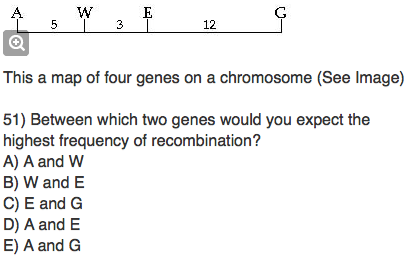
Answer: E
Sturtevant provided genetic evidence for the existence of four pairs
of chromosomes in Drosophila in which of these ways?
A)
There are four major functional classes of genes in Drosophila.
B) Drosophila genes cluster into four distinct groups of linked
genes.
C) The overall number of genes in Drosophila is a
multiple of four.
D) The entire Drosophila genome has
approximately 400 map units.
E) Drosophila genes have, on
average, four different alleles.
Answer: B
Which of the following statements is true of linkage?
A) The
closer two genes are on a chromosome, the lower the probability that a
crossover will occur between them.
B) The observed frequency of
recombination of two genes that are far apart from each other has a
maximum value of 100%.
C) All of the traits that Mendel
studied–seed color, pod shape, flower color, and others–are due to
genes linked on the same chromosome.
D) Linked genes are found
on different chromosomes.
E) Crossing over occurs during
prophase II of meiosis.
Answer: A
How would one explain a testcross involving F₁ dihybrid flies in
which more parental-type offspring than recombinant-type offspring are
produced?
A) The two genes are closely linked on the
same chromosome.
B) The two genes are linked but on different
chromosomes.
C) Recombination did not occur in the cell during
meiosis.
D) The testcross was improperly performed.
E)
Both of the characters are controlled by more than one gene.
Answer: A
A man who carries an alley of an X-linked gene will pass it on to ___.
A) Half of his daughters
B) All of his sons
C) All of his daughters
D) All of his children
Answer: C
Glucose-6-phosphate dehydrogenase deficiency (G6PD) is inherited as a recessive allele of an X-linked gene in humans. A woman whose father suffered from G6PD marries a normal man.
i) What proportion of their sons is expected to be G6PD?
ii) If the husband was not normal but was G6PD deficient, would you change your answer in part i?
A) (i) 1/2 (ii) Yes
B) (i) 100% (ii) No
C) (i) 0 (ii) No
D) (i) 1/2 (ii) No
Answer: D
A mutant bacterial cell has a defective aminoacyl -tRNA synthetase
that attaches a lysine to tRNAs with the anticodon AAA instead of the
normal phenylalanine. The consequence of this for the cell will be
that
A) none of the proteins in the cell will contain
phenylalanine.
B) proteins in the cell will include lysine
instead of phenylalanine at amino acid positions specified by the
codon UUU.
C) the cell will compensate for the defect by
attaching phenylalanine to tRNAs with lysine-specifying anticodons.
D) the ribosome will skip a codon every time a UUU is encountered.
Answer: B
There are 61 mRNA codons that specify an amino acid, but only 45
tRNAs. This is best explained by the fact that
A) some tRNAs
have anticodons that recognize four or more different codons.
B)
the rules for base pairing between the third base of a codon and tRNA
are flexible.
C) many codons are never used, so the tRNAs that
recognize them are dispensable.
D) the DNA codes for all 61
tRNAs but some are then destroyed.
E) competitive exclusion
forces some tRNAs to be destroyed by nucleases.
Answer: B
The release factor (RF) ____.
A) It separates tRNA in the A
site from the growing polypeptide.
B) It binds to the stop codon
in the A site in place of a tRNA.
C) It releases the amino acid
from its tRNA to allow the amino acid to form a peptide bond.
D)
It supplies a source of energy for termination of translation.
E) It releases the ribosome from the ER to allow polypeptides
into the cytosol.
Answer: B
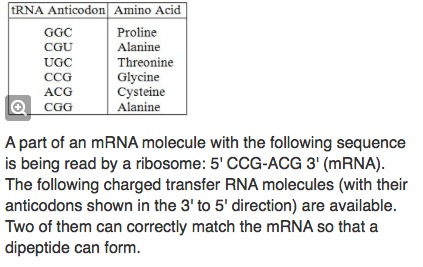
The anticodon loop of the first tRNA that will complement this mRNA
is
A) 3' GGC 5'
B) 5' GGC 3'
C) 5' ACG 3'
D)
5' UGC 3'
E) 3' UGC 5'
Answer: A
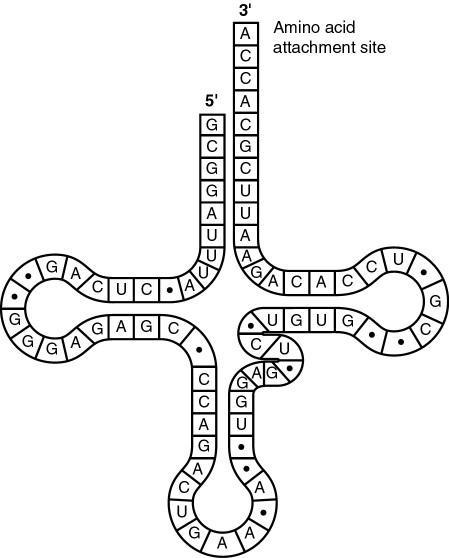
What type of bonding is responsible for maintaining the shape of the
tRNA molecule shown in the figure above?
A) covalent bonding
between sulfur atoms
B) ionic bonding between phosphates
C) hydrogen bonding between base pairs
D) van der Waals
interactions between hydrogen atoms
E) peptide bonding between
amino acids
Answer: C
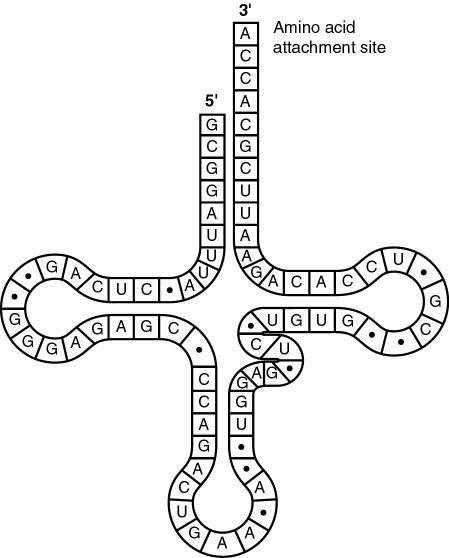
The figure represents tRNA that recognizes and binds a particular
amino acid (in this instance, phenylalanine). Which codon on the mRNA
strand codes for this amino acid?
A) UGG
B) GUG
C)
GUA
D) UUC
E) CAU
Answer: D
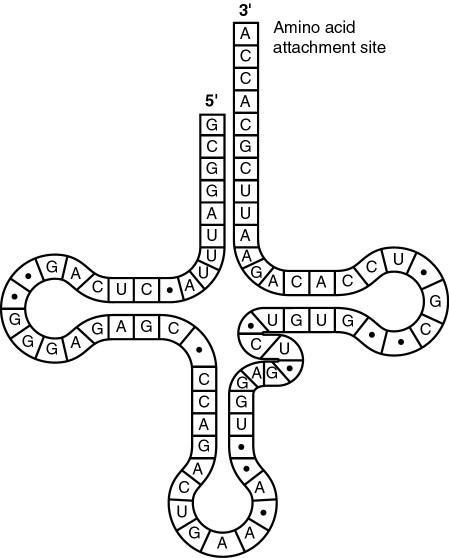
The tRNA shown in the figure has its 3' end projecting beyond its 5'
end. What will occur at this 3' end?
A) The codon and anticodon
complement one another.
B) The amino acid binds covalently.
C) The excess nucleotides (ACCA) will be cleaved off at the
ribosome.
D) The small and large subunits of the ribosome will
attach to it.
E) The 5' cap of the mRNA will become covalently bound
Answer: B
Translation requires ____.
A) mRNA, tRNA, DNA, and rRNA
B) mRNA, tRNA, and rRNA
C) mRNA, tRNa, and DNA
D) mRNA, DNA, and rRNA
Answer: B
Once a peptide has been formed between the amino acid attached to the tRNa in the P site and the amino acid associated with the tRNAi in the A site, what occurs next?
A) initiation
B) reading of the next codon of mRNA
C) tranlocation
D) The codon-anticodon hydrogen bonds holding the tRNA in the A site are broken
Answer: C
Which one of the following, if missing, would usually prevent translation from starting?
A) poly- A tail
B) 5' cap
C) AUG codon
D) exon
Answer: C
Put the following events of elongation in prokaryotic translation in chronological order.
1. Binding of mRNA with small ribosomal subunit
2. Recognition of initiation codon
3. Complementary base pairing between initiator codon and anticodon of initiator tRNA
4. Base pairing of the mRNA codon following the initiator codon with its complementary tRNA
5. Attachment of the large subunit
A) 5,4,3,2,1
B) 1,2,3,5,4
C) 1,2,3,4,5
D) 2,1,4,3,5
Answer: B
How does termination of translation take place?
A) The poly-A tail is reached
B) A stop codon is reached
C) The 5' cap is reached
D) The end of the mRNA molecule is reached
Answer: B
Post-translational modifications of proteins may include the ____.
A) addition of carbohydrates to form a glycoprotein
B) addition of a poly-A tail
C) addition of a 5' cap
D) removal of introns
Answer: A
During elongation, which site in the ribosome represents the location where ac codon is being read?
A) E site
B) A site
C) P site
D) the small ribosomal subunit
Answer: B
What must occur before a newly made polypeptide is secreted from a cell?
A) Its signal sequence must target it to the ER, after which it goes to the Golgi.
B) Its signal sequence must target it to the plasma membrane, where it causes exocytosis
C) Its signal sequence must be cleaved off before the polypeptide can enter the ER
D) It must be translated by a ribosome that remains free within the cytosol
Answer: A
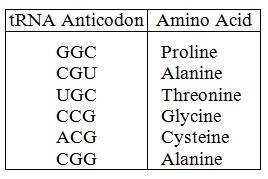
A part of an mRNA molecule with the following sequence is being read by a ribosome: 5' CCG-ACG 3' (mRNA). The following charged transfer RNA molecules (with their anticodons shown in the 3' to 5' direction) are available. Two of them can correctly match the mRNA so that a dipeptide can form.
The dipeptide that will form will be
A) cysteine-alanine.
B) proline-threonine.
C) glycine-cysteine.
D)
alanine-alanine.
E) threonine-glycine.
Answer: B
Which of the following is the first event to take place in
translation in eukaryotes?
A) elongation of the polypeptide
B) base pairing of activated methionine-tRNA to AUG of the
messenger RNA
C) binding of the larger ribosomal subunit to
smaller ribosomal subunits
D) covalent bonding between the first
two amino acids
E) the small subunit of the ribosome recognizes
and attaches to the 5' cap of mRNA
Answer: E
A signal peptide ____.
A) signals the initiation of transcription
B) Helps target a protein to the ER
C) Directs an mRNA molecule into a cisternal space of the ER
D) terminates translation of messenger RNA
Answer: B
Which of the following statements is true about protein synthesis in
prokaryotes?
A) Extensive RNA processing is required before
prokaryotic transcripts can be translated.
B) Translation can
begin while transcription is still in progress.
C) Prokaryotic
cells have complicated mechanisms for targeting proteins to the
appropriate cellular organelles.
D) Translation requires
antibiotic activity.
E) Unlike eukaryotes, prokaryotes require
no initiation or elongation factors.
Answer: B
The most commonly occurring mutation in people with cystic fibrosis
is a deletion of a single codon. This results in
A) a base-pair
substitution.
B) a nucleotide mismatch.
C) a frameshift
mutation.
D) a polypeptide missing an amino acid.
E) a
nonsense mutation.
Answer: D
How might a single base substitution in the sequence of a gene affect the amino acid sequence of a protein encoded by the gene, and why?
A) The amino acid sequence would be substantially altered, because the reading frame would change with a single base substitution.
B) Only a single amino acid could change, because the reading frame is unaffected.
C) All amino acids following the substitution would be affected, because the reading frame would be shifted.
D) It is not possible for a single base substitution to affect protein structure, because each codon is three bases long.
Answer: B
What do we mean when we use the terms monohybrid cross and dihybrid cross?
A) A monohybrid cross results in a 9:3:3:1 ration whereas a dihybrid cross gives a 3:1 ratio.
B) A monohybrid cross involves a single parent, whereas a dihybrid cross involves two parents.
C) A dihybrid cross involves organisms that are heterozygous for two characters that are being studied, and a monohybrid cross involves organisms that are heterozygous for only one character being studied.
D) A monohybrid cross is performed for one generation, whereas a dihybrid cross is performed for two generations.
Answer: C
The fact that all seven of the pea plant traits studied by Mendel obeyed the principle of independent assortment most probably indicates which of the following?
A) All of the genes controlling the traits were located on the same chromosome
B) None of the traits obeyed the law of segregation
C) All of the genes controlling the traits behaved as if they were on different chromosomes
D) The diploid number of chromosomes in the pea plant was 7
Answer: C

In a particular plant, leaf color is controlled by gene locus D. Plants with at least one allele D have dark green leaves, and plants with the homozygous recessive dd genotype have light green leaves. A true-breeding dark-leaved plant is crossed with a light-leaved one, and the F₁ offspring is allowed to self-pollinate. The predicted outcome of the F₂ is diagrammed in the Punnett square shown in Figure 14.1, where 1, 2, 3, and 4 represent the genotypes corresponding to each box within the square.
Which of the boxes marked 1-4 correspond to plants with dark
leaves?
A) 1 only
B) 1 and 2
C) 2 and 3
D) 4
only
E) 1, 2, and 3
Answer: E
Albinism is an autosomal (not sex-linked) recessive trait. A man and woman are both of normal pigmentation and have one child out of three who is albino (without melanin pigmentation). What are the genotypes of the albino's parents?
A) Both are heterozygous
B) One parent must be homozygous for the recessive allele; the other parent must be homozygous dominant, homozygous recessive, or heterozygous.
C) One parent must be homozygous dominant; the other parent must be heterozygous.
D) One parent must be heterozygous; the other parent can be homozygous dominant, homozygous recessive, or heterozygous.
Answer: A
Black fur in mice (B) is dominant to brown fur (b). Short tails (T) are dominant to long tails (t). What fraction of the progeny of crosses BbTt x BBtt will be expected to have black fur and long tails?
A) 9/16
B) 1/2
C) 3/8
D) 1/16
Answer: B
A woman who has blood type A positive has a daughter who is type O positive and a son who is type B negative. Rh positive is a trait that shows simple dominance over Rh negative. Which of the following is a possible phenotype for the father?
A) A negative
B) O negative
C) B positive
D) AB
negative
E) impossible to determine
Answer: C
In humans, ABO blood types refer to glycoproteins in the membranes of red blood cells. There are three allele for this autosomal gene: IA, IB, and i. The IA allele codes for the A glycoprotein. The IB allele codes for the B glycoprotein, and the i allele doesn't code for any membrane glycoprotein. IA and IB are codominant, and i is recessive to both IA and IB. People with type A blood have the genotypes IAIA or IAi, people with type B blood are IBIB or IBi, people with type AB blood are IAIB, and people with type O blood are ii. If a woman with type AB blood marries a man with type O blood, which of the following blood types could their children possibly have?
A) AB and O
B) A and B
C) A, B, AB, and O
D) A, B, and O
Answer: B
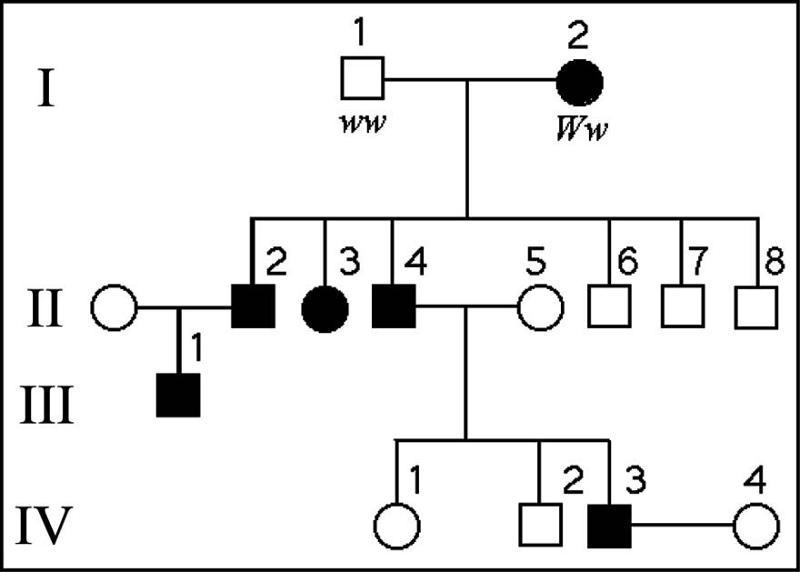
The following question refer to the pedigree chart in Figure 14.2 for
a family, some of whose members exhibit the dominant trait, W.
Affected individuals are indicated by a dark square or circle.
What is the genotype of individual II-5?
A) WW
B) Ww
C) ww
D) WW or ww
E) ww or Ww
Answer: C
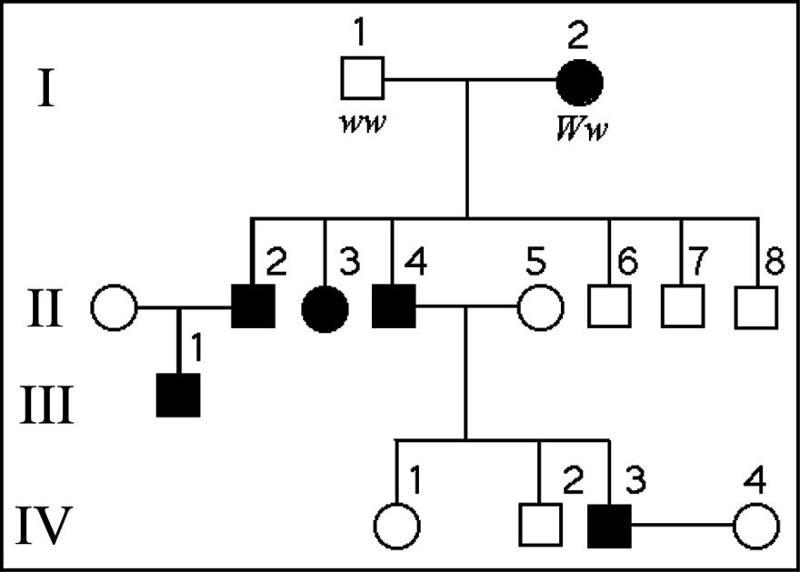
What is the likelihood that the progeny of IV-3 and IV-4 will have
the trait?
A) 0%
B) 25%
C) 50%
D) 75%
E) 100%
Answer: C
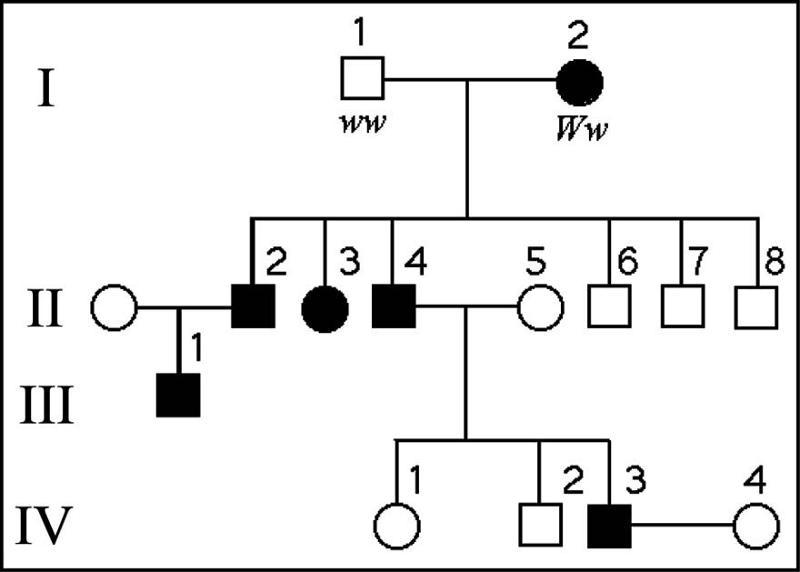
What is the probability that individual III-1 is Ww?
A) 3/4
B) 1/4
C) 2/4
D) 2/3
E) 1
Answer: E
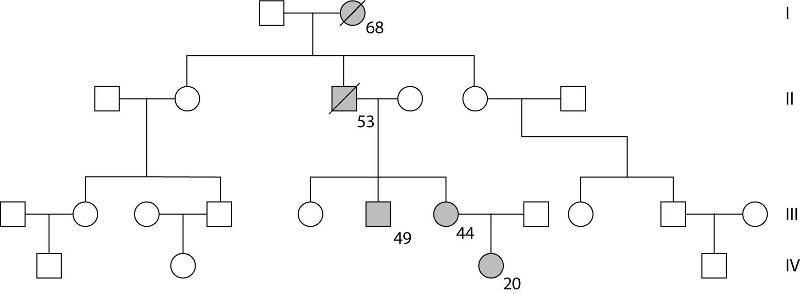
Use the following pedigree (Figure 14.3) for a family in which dark-shaded symbols represent individuals with one of the two major types of colon cancer. Numbers under the symbols are the individual's age at the time of diagnosis.
From this pedigree, how does this trait seem to be inherited?
A) from mothers
B) as an autosomal recessive
C) as a
result of epistasis
D) as an autosomal dominant
E) as an
incomplete dominant
Answer: D
Which of the following statements is a correct explanation for the observation that all offspring exhibit a phenotype for a particular trait that appears to be a blend of the two parental varieties?
A) Neither of the parental genes is dominant over the other
B) The genes are linked and do not separate during meiosis
C) The genes for the trait are recessive in both of the parents
D) The genes for the trait are dominant in both parents
Answer: A
A gene for the MN blood group has codominant alleles M and N. If both children are of blood type M, which of the following is possible?
A) Each parent is either M or MN.
B) Each parent must be type M
C) Neither parent can have the N allele
D) Both children are heterozygous for this gene
Answer: A
In certain plants, tall is dominant to short. If a heterozygous plant
is crossed with a homozygous tall plant, what is the probability that
the offspring will be short?
A) 1
B) 1/2
C) 1/4
D) 1/6
E) 0
Answer: E
In the cross AaBbCc × AaBbCc, what is the probability of producing
the genotype AABBCC?
A) 1/4
B) 1/8
C) 1/16
D)
1/32
E) 1/64
Answer: E
A black guinea pig crossed with an albino guinea pig produced twelve black offspring. When the albino was crossed with a second black animal, six blacks and six albinos were obtained. What is the best explanation for this genetic situation?
A) Albino is recessive; black is dominant
B) Albino is recessie; black is codominant
C) Albino and black are codominant
D) Albino is dominant; black is incompletely dominant
Answer: A
Gray seed color in peas is dominant to white. Assume that Mendel conducted a series of experiments where plants with gray seeds were crossed among themselves, and the following progeny were produced: 302 gray and 98 white.
(i) What is the probable genotype of each parent?
(ii) Based on your answer, what genotypic and phenotypic ratios are expected in these progeny? G= gray and g=white
A) Gg x Gg; genotypic= 1:2:1, phenotypic = 3:1
B) gg x Gg; genotypic = 1:2, phenotypic = 3:1
C) GG x gg; genotypic = 3:1, phenotypic= 1:2:1
D) GG x Gg; genotypic = 1:2:1, phenotypic = 2:1
Answer: A

In a particular plant, leaf color is controlled by gene locus D. Plants with at least one allele D have dark green leaves, and plants with the homozygous recessive dd genotype have light green leaves. A true-breeding dark-leaved plant is crossed with a light-leaved one, and the F₁ offspring is allowed to self-pollinate. The predicted outcome of the F₂ is diagrammed in the Punnett square shown in Figure 14.1, where 1, 2, 3, and 4 represent the genotypes corresponding to each box within the square.
Which of the boxes correspond to plants with a heterozygous
genotype?
A) 1
B) 1 and 2
C) 1, 2, 3 and 4
D)
2 and 3
Answer: D
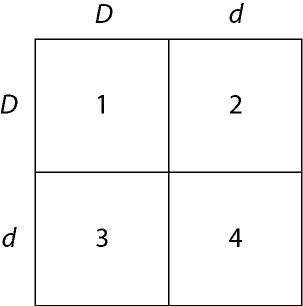
Which of the plants will be true-breeding?
A) 1 and 4 only
B) 2 and 3 only
C) 1, 2, 3, and 4
D) 1 only
E)
1 and 2 only
Answer: A
Skin color in a certain species of fish is inherited via a single
gene with four different alleles.
How many different types of gametes would be possible in this
system?
A) 1
B) 2
C) 4
D) 8
E) 16
Answer: C
Mendel's observation of the segregation of alleles in gamete
formation has its basis in which of the following phases of cell
division?
A) prophase I of meiosis
B) anaphase II of
meiosis
C) metaphase I of meiosis
D) anaphase I of meiosis
E) anaphase of mitosis
Answer: D
What was the most significant conclusion that Gregor Mendel drew from
his experiments with pea plants?
A) There is considerable genetic variation in garden peas.
B) Traits are inherited in discrete units, and are not the
results of "blending."
C) Recessive genes occur more
frequently in the F₁ generation than do dominant ones.
D) Genes
are composed of DNA.
E) An organism that is homozygous for many
recessive traits is at a disadvantage.
Answer: B
The individual with genotype AaBbCCDdEE can make many kinds of
gametes. Which of the following is the major reason?
A)
segregation of maternal and paternal alleles
B) recurrent
mutations forming new alleles
C) crossing over during prophase I
D) different possible assortment of chromosomes into
gametes
E) the tendency for dominant alleles to segregate together
Answer: C
Why did Mendel continue some of his experiments to the F₂ or F₃
generation?
A) to obtain a larger number of offspring on which to base
statistics
B) to observe whether or not a recessive trait would
reappear
C) to observe whether or not the dominant trait would
reappear
D) to distinguish which alleles were segregating
E) to be able to describe the frequency of recombination
Answer: B
Which of the following about independent assortment and segregation
is correct?
A) The law of independent assortment requires
describing two or more genes relative to one another.
B) The law
of segregation requires describing two or more genes relative to one
another.
C) The law of segregation requires having two or more
generations to describe.
D) The law of independent assortment is
accounted for by observations of prophase I.
E) The law of
segregation is accounted for by anaphase of mitosis.
Answer: A
A sexually reproducing animal has two unlinked genes, one for head
shape (H) and one for tail length (T). Its genotype is HhTt. Which of
the following genotypes is possible in a gamete from this organism?
A) tt
B) Hh
C) HhTt
D) T
E) HT
Answer: E
An original section of DNA has the base sequence AGCGTTACCGT. A mutation in this DNA strand results in the base sequence AGGCGTTACCGT. This change represents _____.
A) A silent mutation
B) A frameshift mutation
C) A point mutation
D) A missense mutation
Answer: B
A single base substitution mutation is least likely to be deleterious when the base change results in ____.
A) A codon that specifies the same amino acid as the original codon
B) A stop codon
C) An amino acid substitution that alters the tertiary structure of the protein
D) An amino acid substitution at the active site of an enzyme
Answer: A
Rank the following one-base point mutations (from most likely to least likely) with respect to their likelihood of affecting the structure of the corresponding polypeptide.
1. insertion mutation deep within an intron
2. substitution mutation at the third position of an exonic codon
3. substitution mutation at the second position of an exonic codon
4. deletion mutation within the first exon of the gene
A) 2,1,4,3
B) 1,2,3,4
C) 3,1,4,2
D) 4,3,2,1
Answer: D
Of the following, which is the most current description of a gene?
A) A unit of heredity that causes formation of a phenotypic characteristic
B) A DNA subunit that codes for a single complete protein
C) a discrete unit of hereditary information that consists of a sequence of amino acids
D) A DNA sequence that is expressed to form a functional product: either RNA or polypeptide
Answer: D
Which of the following types of mutation, resulting in an error in the mRNA just after the AUG start of translation, is likely to have the most serious effect on the polypeptide product?
A) a substitution of the first nucleotide of the GGG codon
B) a substitution of the third nucleotide in an ACC codon
C) a deletion of two nucleotides
D) a deletion of a codon
Answer: C
A nonsense mutation in a gene ____.
A) has no effect not he amino acid sequence of the encoded protein
B) introduces a premature stop codon into the mRNA
C) alters the reading frame of the mRNA
D) changes an amino acid in the encoded protein
Answer: B
Which of the following DNA mutations is most likely to damage the protein it specifies?
A) a codon deletion
B) an addition of three nucleotides
C) a base-pair deletion
D) a substitution in the last base of a codon
Answer: C